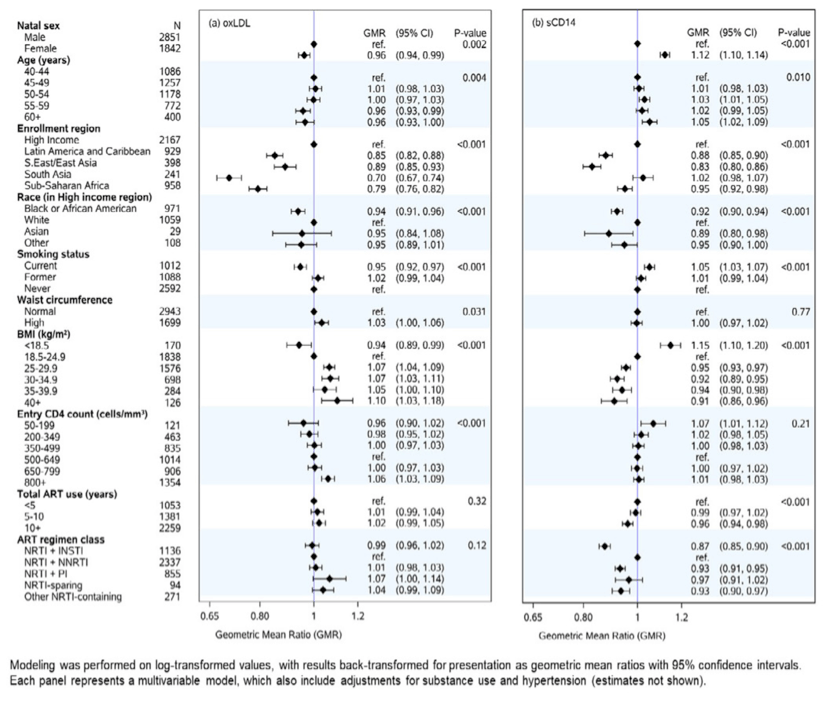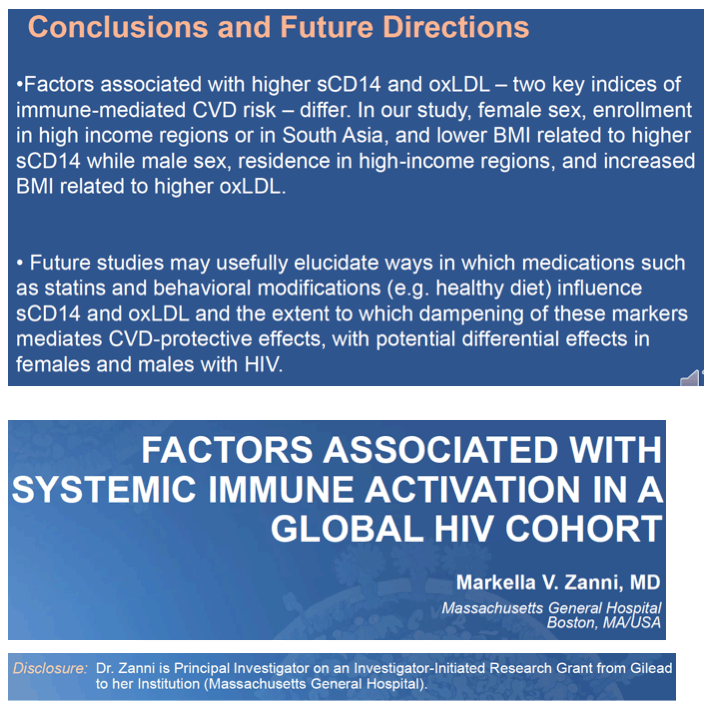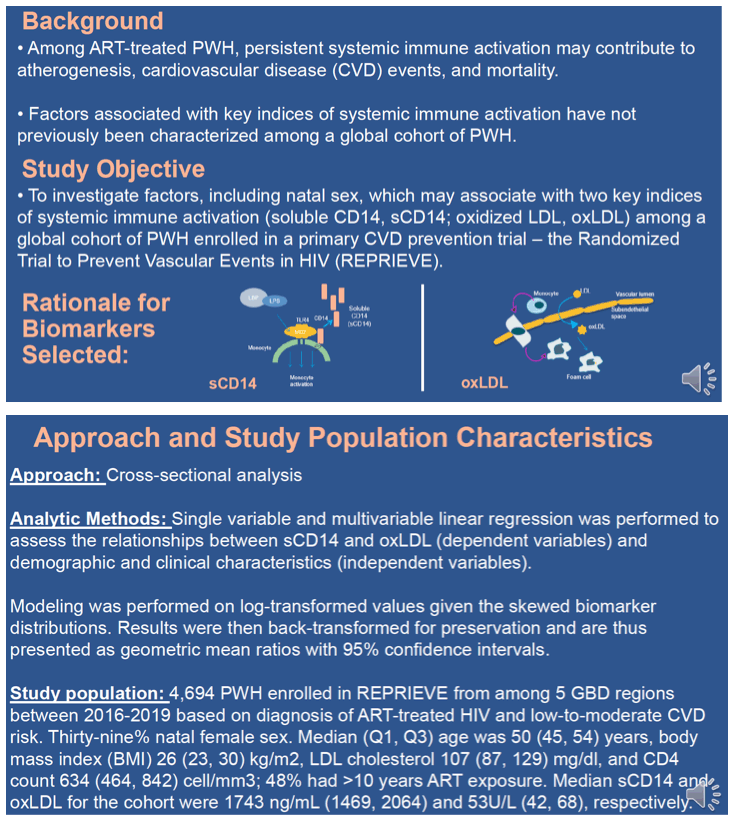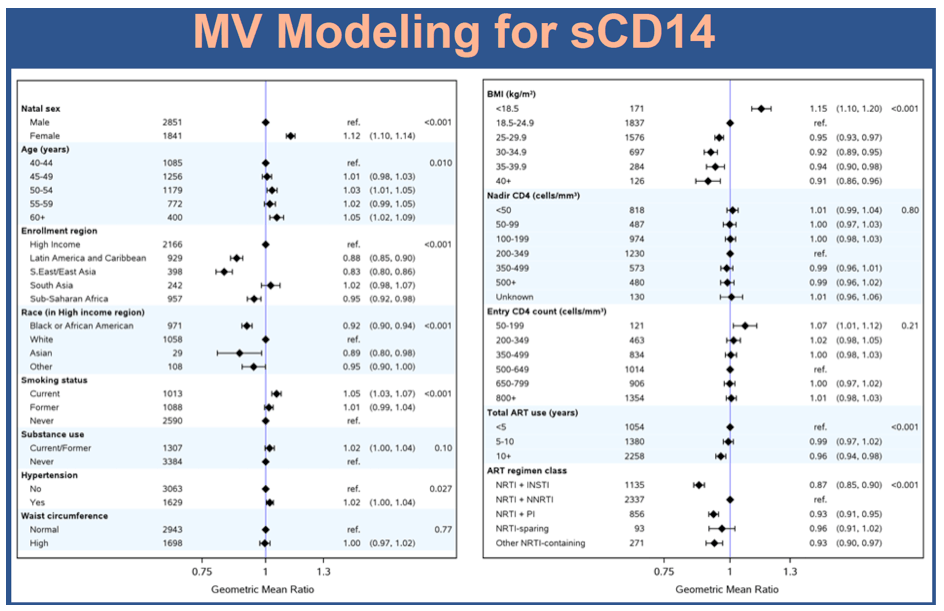 |
 |
 |
| |
FACTORS ASSOCIATED WITH SYSTEMIC IMMUNE ACTIVATION IN A GLOBAL HIV COHORT
|
| |
| |
CROI: ASSESSMENT OF OBESITY AND METABOLIC PROFILE BY INTEGRASE INHIBITOR USE IN REPRIEVE - (03/09/21)
CROI 2021 March 6-10 Reported by Jules Levin
Sara E . Looby1, Amy Kantor2, Tricia H. Burdo3, Judith S. Currier4, Carl Fichtenbaum5, E. Turner Overton6, Judith A. Aberg7, Carlos Malvestutto8, Gerald S. Bloomfield9, Kathleen Fitch1, Pamela S. Douglas9, Steven Grinspoon1, Heather J. Ribaudo2, Markella V. Zanni1, for the REPRIEVE Investigators
1Massachusetts General Hospital, Boston, MA, USA, 2Harvard TH Chan School of Public Health, Boston, MA, USA, 3Temple University, Philadelphia, PA, USA, 4University of California Los Angeles, Los Angeles, CA, USA, 5University of Cincinnati, 6Cincinnati,OH,USA, University of Alabama at Birmingham, Birmingham, AL, USA, 7 Icahn School of Medicine at Mt Sinai, NewYork,NY,USA, 8The Ohio State University, 9Columbus,OH,USA, Duke University, Durham,NC,USA
Background: Among antiretroviral therapy (ART)-treated people with HIV (PWH), persistent systemic immune activation may contribute to atherogenesis, cardiovascular disease (CVD) events, and mortality. Factors associated with key indices of systemic immune activation have not previously been characterized among a global cohort of PWH.
Methods: REPRIEVE (Randomized Trial to Prevent Vascular Events in HIV) enrolled ART-treated PWH age 40-75 with low-to-moderate traditional CVD risk. Among a subset of REPRIEVE participants, baseline levels of oxidized LDL cholesterol (oxLDL) and soluble CD14 (sCD14) were characterized by ELISA. Multivariable linear regression was used to examine levels of oxLDL and sCD14 by natal sex, geographic region, and age and to evaluate other participant characteristics associated with each marker.
Results: The cohort included 4694 participants from 5 Global Burden of Disease regions (39% female sex, 48% Black). Median (Q1, Q3) age was 50 (45, 54) years, body mass index (BMI) 26 (23, 30) kg/m2, LDL cholesterol 107 (87, 129) mg/dl, and CD4 count 634 (464, 842) cell/mm3; 48% had >10 years ART exposure. Median oxLDL and sCD14 for the cohort were 53 U/L (42, 68) and 1743 ng/mL (1469, 2064). Controlling for age and sex, oxLDL was highest in high-income regions and lowest in Sub-Saharan Africa and South Asia, while sCD14 was lowest in Latin America and S. East/East Asia. Aside from regional variation, male sex, younger age, white race (in high-income regions), and higher BMI and waist circumference were associated with higher oxLDL (Panel a). Female sex, older age, white race, current cigarette smoking, and lower BMI were associated with higher sCD14 (Panel b). Differences by current ART use were also apparent for sCD14. Findings were similar in sex-stratified analyses, analyses adjusted for levels of LDL cholesterol (oxLDL only), and sensitivity analyses restricted to participants with undetectable HIV-1 RNA.
Conclusion: Factors associated with higher oxLDL and sCD14 - two key indices of immune-mediated CVD risk - differ. Male sex, residence in high-income regions, and higher BMI relate to higher oxLDL, while female sex, current cigarette smoking, and lower BMI relate to higher sCD14. Future studies may usefully elucidate ways in which medications and behavioral modifications (e.g. healthy diet, smoking cessation) influence oxLDL and sCD14 and whether dampening of these markers mediates CVD-protective effects.





|
| |
|
 |
 |
|
|